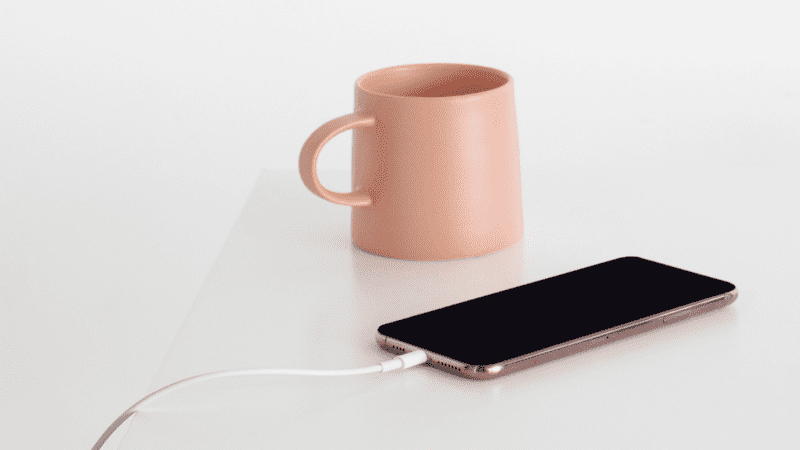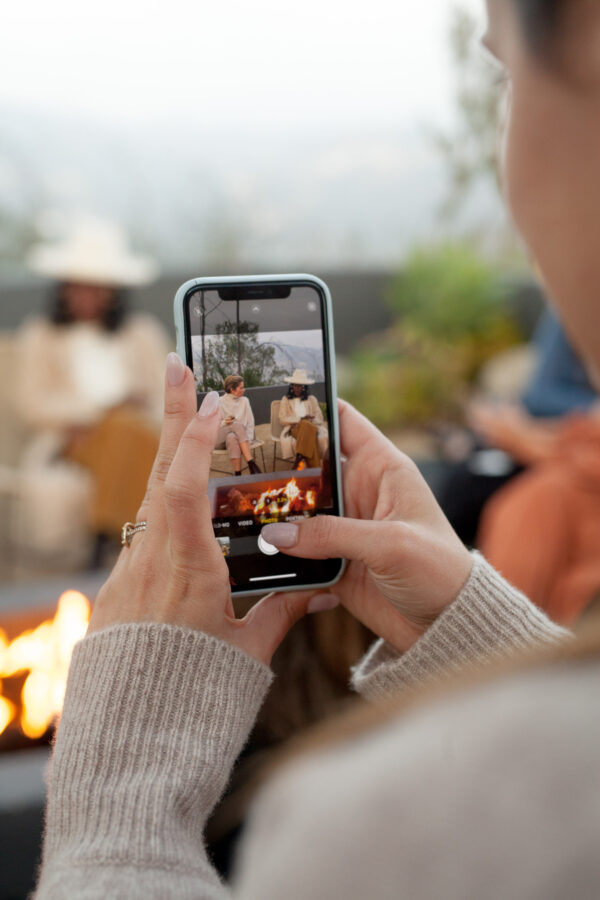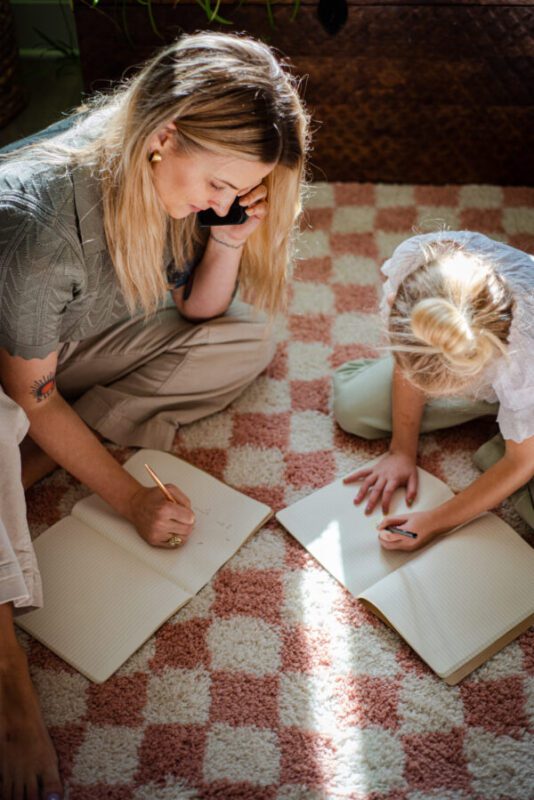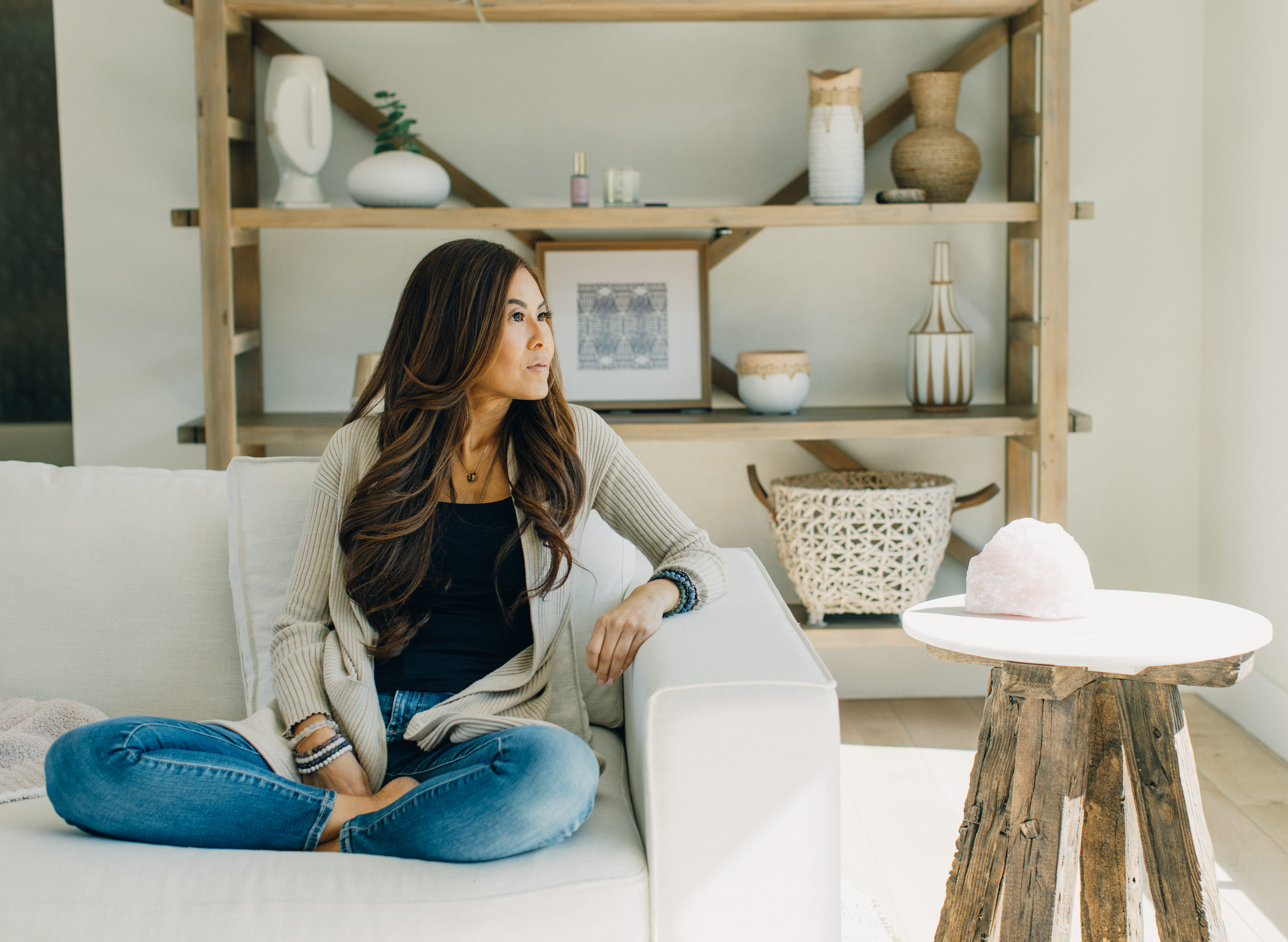Key Takeaways
- Mindful tech use restores balance: A 4-week digital detox—through usage tracking, journal reflections, and device-free rituals—rewires your brain for calm and focus.
- Protects mental health and family connection: Reducing screen time lowers stress, improves sleep, and models healthy boundaries for children.
- Sustainable habits matter: Transition to value-driven app use, tech-free zones, and weekly “sabbath” breaks for lasting emotional resilience and energetic clarity.
My clients often admit that they feel ruled by tech. They love how it helps them multi-task and keep in touch with friends and trending news, but they feel trapped by 24/7 info and social media overload.
Last month a young client admitted that by bedtime she felt so drained and anxious she could barely remember her daughter’s bedtime story. Her phone had been buzzing all evening with news alerts and social notifications. I see this pattern again and again: We invite technology in to simplify our lives only to find it fragmenting our attention, heightening our stress response, and actually dimming our inner light.
Too Much Screen Time
Our brains are amazingly adaptable. In childhood and adolescence, they are especially shaped by experience. These days, too much of that experience likely comes from constant social media checks, news updates, or late-night gaming sessions. As a result, our brains begin to wire themselves for instant reward rather than deep focus and emotional resilience.
Brain Changes
Frequent social media use shifts activity toward the amygdala, our emotional center, making us more reactive to perceived criticism and praise. A 2023 JAMA Pediatrics study (1) found that teens who checked social media ten or more times per day showed greater neural sensitivity to likes and comments, which put them at higher risk for anxiety and low self-esteem.
Heavy screen time can delay synaptic pruning in the prefrontal cortex. During this brain-development process, less frequently used neural connections are eliminated, making room for stronger (more frequently used) connections. The prefrontal cortex is the region that governs planning, impulse control, and emotional regulation, and, over time, heavy tech usage may leave us more prone to distraction and decision fatigue (2).
Emotional Health and Sleep
In a 2023 CDC Youth Risk Behavior Survey (3), nearly three in five teen girls reported persistent feelings of sadness or hopelessness, the highest level in a decade, and this trend parallels rising screen use and online harassment.
Blue light from screens suppresses melatonin production. Adolescents who use devices in the hour before bed experience shorter, shallower sleep. Poor sleep disrupts the brain’s glymphatic cleaning system, making it harder to process emotions and solidify memory (4).
Reward Pathways and Digital Addiction
Social media platforms use variable-reward reinforcement—unpredictable “hits” of likes and comments—to hijack dopamine pathways. Brain scans from UCLA show that teens with high social media engagement have overactive reward centers and underactive self-control networks, creating a pattern similar to substance addiction (5).
From a Reiki perspective I also sense how constant screen time fragments our energetic field, overloading the third-eye center and depleting grounding energy in the root and heart centers. Without regular energetic clearing we become prone to anxiety, scattered thinking, and a sense of disconnection from our true selves.
 How Tech Overload Shapes Our Children
How Tech Overload Shapes Our Children
When we worry about our own screen habits, we often overlook how deeply our children and partners are affected. As parents or caregivers, we model technology use, setting the example for what “normal” engagement looks like.
Girls
Adolescent and preadolescent girls tend to process social feedback more sensitively, leading to real mental health issues. Endless scrolling through picture-perfect feeds is damaging. Without the space and grace to discover their individuality, girls can feel anxiety, chronic self-doubt, and disordered eating patterns. Teen girls can develop a heightened need for external validation that undermines their authentic self-worth (6).
Boys
Teen boys, too, may be a little less drawn to appearance comparison but it still exists. Scrolling for long periods of time through posts that highlight physical performance are equally harmful. And many boys face the draw of competitive gaming and binge-watching, which can reprogram the brain towards high-stimulus reward seeking. Over time, this blunts motivation for a wider variety of activities, erodes impulse control, and can result in aggression or emotional detachment (7).
Family Dynamics
When everyone at the dinner table is on a device, we miss shared moments that build empathy, communication skills, and genuine connection. Children learn rules by watching us. If parents constantly multitask with screens, then kids internalize that it’s okay to be perpetually checking in rather than present and focused. Plus, it’s simply not behavior we would want our kids to ever emulate.

A Four-Week Tech Detox
This technology detox isn’t about strict prohibition. It’s about consciously choosing when and how we engage with devices. Invite your partner to try this gentle detox with you.
Week One: Awareness
1. Track Usage
Have each person note daily screen time for social media, news, games, and non-essential browsing. Don’t hesitate to extend tracking to two weeks if your work requires heavier screen use.
2. Feelings Journal
Before and after major screen sessions write one word, such as energized, anxious, distracted, or calm.
3. Device-Free Rituals
Introduce a 10-minute device-free activity into your life to do alone or with friends or family. Each evening, plan some stretching, breathwork, or read a physical book.
Week Two: Lightening
1. App Audit
Review your tracking journal to discover which software applications you spend most time on (and you see take most of your energy), then delete at least one of them.
2. Notification Reset
Turn off all push notifications except for urgent calls or messages.
3. First/Last Screen Windows
Declare the first and last 30 minutes of each day as screen-free. Replace scrolling with journaling, drawing, or stretching.
Week Three: Mini Detox Weekends
1. 48-Hour Unplug
Choose one weekend to power down non-essential devices from Friday evening to Sunday evening.
2. Mindful Activities
Plan a nature walk, cook a plant-based meal for friends or family, do yoga in the living room, or plan a family art project.
3. Reiki Sharing Circle
Gather after breakfast each day for a 10-minute group Reiki session. Have each person set an intention for the day.
Week Four: Sustainable Integration
1. Value-Driven Reintroduction
Bring back only the apps and tech tools that clearly add value—wellness apps, educational resources, or creative platforms. If you need to cut down on distractions, install blocking tech for during work hours.
2. Screen-Free Zones and Times
Establish device-free spaces (bedrooms, dinner table) and times (an hour after work/school). Schedule phone-free social outings (coffee with friends, group walks) to replace passive screen breaks.
3. Weekly Tech Sabbatical
Plan a full day each week—Sunday or any day that works for you—without non-essential screens. Use that time for connection, creativity, rest, and energy healing.
In the end, restoring balance with technology is an act of self-compassion. Not only that, it builds resilience.
As a longevity expert, I know that our mental and emotional health is just as crucial as our physical nourishment. By modeling mindful tech use for our loved ones, we pave the way for a balance.
Remember, every conscious choice rewires your brain for greater calm, clarity, and joy.
xo – Serena
Frequently Asked Questions (FAQ):
Q. How can I accurately track my family’s screen time without relying solely on device settings?
A. Consider using cross-device monitoring tools like Screen Time (built into iOS) paired with Google Family Link (for Android). These apps can aggregate usage across devices and provide detailed reports. For younger children, you can also use routers with built-in parental dashboards to see overall household patterns.
Q. What are early warning signs of “tech addiction” that parents should watch for?
A. Here are a few likely signs. If you notice two or more signs persisting for several weeks, it may be time to seek guidance from a pediatrician or mental-health professional.
- Loss of interest in offline hobbies or family activities
- Irritability, restlessness, or anxiety when separated from devices
- Sneaking extra screen time or not being transparent about usage
- Decline in academic performance or irregular sleep patterns
Q. How do I adapt the four-week detox plan for young children (under age 10)?
A. Try these steps:
- Shorten detox windows to 30–60 minutes rather than hours.
Replace digital activities with age-appropriate alternatives: puzzles, coloring, outdoor play. - Use a visual timer or sand timer to help them anticipate when screen time will resume.
- Make the process into a family game or challenge, offering small non-screen rewards for meeting daily goals.
Q. What should I do if a family member refuses to participate in the detox?
A. This is a common situation. Try to lead by example. Share your own usage data and improvements in mood and sleep. Invite them to try one small change first (e.g. no devices during meals) and celebrate successes. And frame it as a mental-health experiment, not a punishment, and emphasize the benefits you’re already experiencing.
Q. How often should I incorporate Reiki or energy-clearing when doing the detox?
A. Aim for two to three brief Reiki self-treatments (5–10 minutes each) per week during the detox, focusing on the root and heart chakras to ground and nurture emotional balance. If you have access to a trained practitioner, a full 60-minute session at the start or midpoint can deepen your results.
Q. How can I maintain the benefits of the detox long-term?
A. Here are a few strategies:
- Schedule a monthly “screen audit” to remove new apps or reset notifications.
- Keep your tech sabbatical habit, even if shortened to a few hours.
- Reinforce positive apps (meditation, creativity) that keep you engaged in healthy digital routines.
Q. What if my teen needs screens for school but also struggles with overuse?
A. This is a classic conundrum. Try:
- Use separate user profiles or distinct browsers: one for “School Mode” with only educational apps, and one for “Leisure Mode”.
- Leverage built-in focus modes (iOS Focus, Android Digital Wellbeing) to block non-academic apps during class or homework time.
- Encourage structured breaks: 25 minutes of work, then a 5 to 10-minute rest to go outside and move a bit, if possible.
Q. How do I discuss tech balance without sounding judgmental or authoritarian?
A. Share your personal journey, challenges, and small wins. Ask open-ended questions like, “how do you feel after scrolling for twenty minutes?” Invite collaboration for creating some screen-free rituals. Finally, focus on shared goals, like better sleep, more family fun, or reduced stress, rather than “rules” alone.
Citations:
- Maza MT, Fox KA, Kwon SJ, Flannery JE, Lindquist KA, Prinstein MJ, Telzer EH. Association of Habitual Checking Behaviors on Social Media With Longitudinal Functional Brain Development. JAMA Pediatr. 2023 Feb 1;177(2):160-167. doi: 10.1001/jamapediatrics.2022.4924. Erratum in: JAMA Pediatr. 2023 Apr 1;177(4):440. doi: 10.1001/jamapediatrics.2023.0001. PMID: 36595277; PMCID: PMC9857400.
- Screen Media Overuse and Associated Physical, Cognitive, and Emotional/Behavioral Outcomes in Children and Adolescents: An Integrative Review, Liu, Jianghong et al. Journal of Pediatric Health Care, Volume 36, Issue 2, 99 – 109
- https://www.cdc.gov/yrbs/results/2023-yrbs-results.html
- Silvani MI, Werder R, Perret C. The influence of blue light on sleep, performance and wellbeing in young adults: A systematic review. Front Physiol. 2022 Aug 16;13:943108. doi: 10.3389/fphys.2022.943108. PMID: 36051910; PMCID: PMC9424753.
- https://www.uclahealth.org/news/release/the-teenage-brain-on-social-media
- Dose-dependent and joint associations between screen time, physical activity, and mental wellbeing in adolescents: an international observational study, Khan, Asaduzzaman et al. The Lancet Child & Adolescent Health, Volume 5, Issue 10, 729 – 738
- Kelly S, Magor T, Wright A. The Pros and Cons of Online Competitive Gaming: An Evidence-Based Approach to Assessing Young Players’ Well-Being. Front Psychol. 2021 May 10;12:651530. doi: 10.3389/fpsyg.2021.651530. PMID: 34040562; PMCID: PMC8142893.
by


 How Tech Overload Shapes Our Children
How Tech Overload Shapes Our Children



